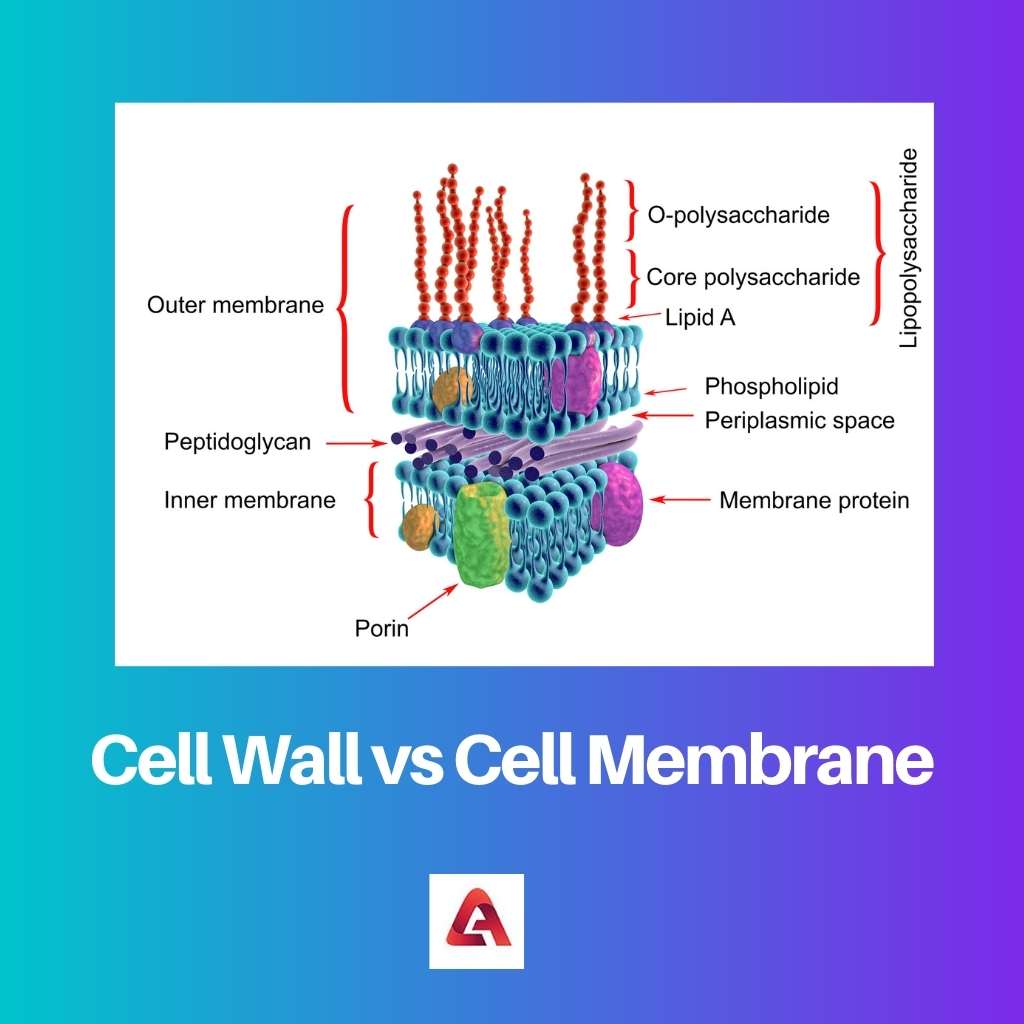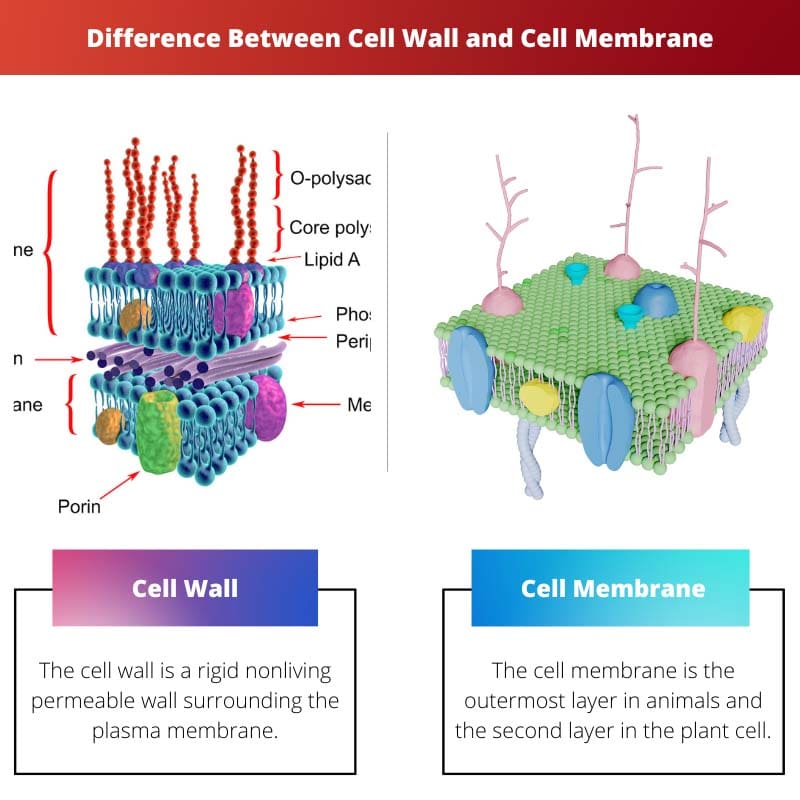A cell is a critical unit of life and is present in all living organisms and beings. The form and dimensions of the cells differ regarding their purpose and life form.
The cell wall and cell membrane are the main elements of a cell. The cell wall is the outermost layer and is present in plant cells, and the cell membrane is present in all the cells.
Key Takeaways
- Cell walls are rigid structures found in plant cells, fungi, and some bacteria, providing support and protection.
- Cell membranes are flexible, semi-permeable layers surrounding all cells, regulating the movement of substances.
- Cell walls comprise cellulose, chitin, or peptidoglycan, while cell membranes comprise phospholipids and proteins.
Cell Wall vs Cell Membrane
The cell wall is a tough, flexible, and sometimes rigid layer surrounding only plant cells. It protects the cell from attack by harmful organisms. A cell membrane is a biological membrane that protects the inside of a cell from the outside environment. It is present in all types of cells.

The cell wall is a rigid nonliving permeable wall surrounding the plasma membrane. It supports and is present in plants, bacteria, and algae. It controls the movement of molecules that enters the cells.
It protects the cell from physical damage and protects from bacteria that harm the cell. It maintains the cell from the pressure exerted by water storage.
The cell membrane is the outermost layer in animals and the second layer in the plant cell. It maintains the cell structure and ensures the functioning of the cell, and it is semi-permeable which is selective movements into the cell.
It only allows the movement of solvent and a few solutes. A solvent is a liquid that permits other substances to dissolve, and a solute is a substance that gets dissolved. In the sugar solution, water is a solvent, and sugar is a solute.
Comparison Table
| Parameters of Comparison | Cell Wall | Cell Membrane |
|---|---|---|
| Presence | Present in plant cells, bacteria, and algae. | It is present in all cells. |
| Thickness | As it ages the thickness grows. | It remains the same the entire time. |
| Nutrition | It needs no nutrition to survive. | It needs nutrition to survive. |
| Porous | It is completely porous. | It is semi-porous. |
| Visibility | It is noticeable under a microscope. | It is noticeable under an electronic microscope. |
What is a Cell Wall?
The cell wall is a thick semi-rigid protective layer covering the cell membrane. It protects and gives shape to the structure. The cell wall is the outermost layer, and the thickness depends on the species.
Functions of the cell wall:
The crucial function of the cell wall is to protect the internal structure of the cell as it is fragile. The internal form cannot safeguard itself from external entities. The cell wall provides the shape to the cells.
In case of any additional internal pressure on the cell membrane, the cell wall ensures the cell does not expand and rupture. The cell wall controls the passage of molecules, hence protecting them from toxins and harmful chemicals.
In plants, the cell wall is responsible for turgidity (swollen due to fluids). The cell wall protects the plant cell from bursting from excessive water by withstanding the osmotic pressure.
Some plants have cell walls with a single layer, and a few have two layers. The second layer is high in lignin, which helps waterproof the cell.
Cell Wall Structure:
The cell wall is present in all plant cells, fungi, bacteria, algae, and some archaea and the composition of the cell wall varies along with the organism.
The plant cell wall has three layers made of carbohydrates and minerals. The three layers are primary, secondary, and middle lamella.

What is a Cell Membrane?
The cell membrane gets even referred to as the plasma membrane. It has a double layer of protein and lipids that encloses the cell.
The crucial function of the cell membrane is it provides the cell structure and regulates the entry and exit of the materials into the cell.
The cell membrane is selectively permeable, which implies it selects what could pass through it. Smaller molecules like oxygen and carbon dioxide can effortlessly enter and exit the cell membrane.
Oxygen is vital for respiratory and carbon dioxide if the byproduct of the function. Water gets to pass freely with a much slower movement.
Functions of Cell Membrane:
- The cell membrane provides the shape and structure of the cell.
- The cell membrane protects the cytosol from any external threats.
- It balances the motion of matter in the cell.
- It helps in cell communication and cell recognition-The cells recognize the environment and communicate with each other.
The cell membrane transports proteins and nutrients at concentrated levels. Due to the membrane barrier, the cell accumulates the higher nutrients and disposes of the waste materials.
The cell membrane requires appropriate nutrition to survive and maintains the same thickness throughout life.

Main Differences Between Cell Wall and Cell Membrane
- The cell wall is the outer layer that surrounds the cell, and it provides strength to the cell. The cell membrane is a delicate structure that protects the protoplasm.
- Thy cell wall is there in a plant cell, fungi, bacteria, and algae. All cells have a cell membrane.
- The cell wall is a thick layer easily visible under a microscope. The cell membrane is a narrow surface that is only noticeable under an electron microscope.
- The cell wall thickness grows over the years along with their cell. The cell membrane remains the same during its lifetime.
- The cell wall does not require any nutrition. The cell membrane needs proper nutrition to survive.

- https://www.sciencedirect.com/science/article/pii/S016816561400830X
- https://www.microbiologyresearch.org/content/journal/ijsem/10.1099/00207713-20-4-509?crawler=true
